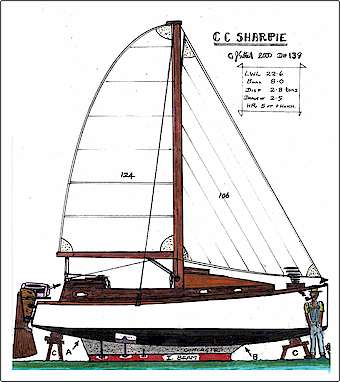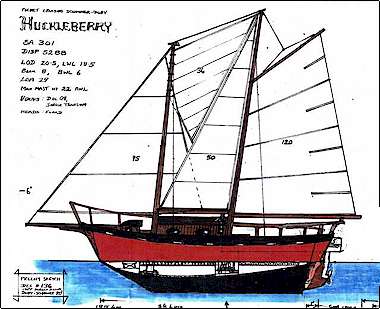Dreamboats
by Jeff Gilbert jgilbert@dynamite.com.au
January, 2001
How Difficult Need It be?
Because I live in Australia & its very hot in summer, I can
be somewhat affected this time of year. "Gone Troppo", is the correct Medical
Term. And so this idea for building a boat, born of fiberglassing in the Australian heat,
an activity equivalent in fun to rolling rocks uphill in a hair shirt.
OK you want a boat you can weekend in, and don’t want to die in the
attempt of building, neither be murdered by your spouse or bank manager (these may well be
the same person, which doubles the danger).
The simplest form to build is a flattie, dory, sharpiestyle, and the flat
bottom offers the possibility of dispensing with flooring. So dory it is, no built in
curves, no torturing of plywood, which is the obvious choice of material given the flying
start that a sheet leaks less than a bunch of joined planks!
1/ Make the flat sole-cum-bottom
Buy twelve sheets of 17mm marine ply (make ‘em deliver it free!!) which
costs but is worth it as this is a major element of the build. Your boats going to be
about 20 and change feet so you butt glue up six sheets, temp fixing to a floor or lumber
rails. Epoxy coat the top surface & plonk another six on top, cutting the end one into
2 sheets of 8 x 2 to get a full overlap.
2/ Lay down a steel I beam as per plans obtained from some looney like me.
Lets use the CC sharpie in the sketch. Drill the top plate of the I beam to
take SS bolts every 20cm, then box the beam up for concrete, cutting side sheets of ply to
the bottom shape from A to B. Put some steel in it, and make a top plate of ¼ inch
rubbish ply drilled with holes to fix and take the bolt heads. With the bolts propped up,
pour the concrete to the top of the form then bolt the rubbish ply down on top hard with
all your bolts poking through..
3/ When your concrete is set unscrew the nuts off your keel bolts and remove
the rubbish ply top. Use this as a template up the centreline of your floor (1) above to
markout and drill your floor holes. Mark out the bottom shape with battens.
4/ Strip the rest of the boxing and bolt the floor on. You use a 12 x 3 ft
sheet of 4mm steel plate as a giant washer, cut out to the pattern of your trusty rubbish
ply boxing top. You need to bribe mates with beer to lift the 24 x 8 floor.It takes the
right shape at A through B but you need to brace it at C etc. to get your smooth bottom
curve. You’ll also need to level up to get the WL correct - this is worked out on
predicted displacement by some mathematically inclined looney like …never mind, its
in the plan. Your bow and stern will be just above the WL, and it’s a whole lot
easier if you have a flat floor. Initially putting your dreaded I beam up a bit gives you
a better working height.
When the floor’s on, use the template rubbish ply to mark out another two
sheets of ply,with the holes oversize and not all the way thru. Spot weld your bolts and
glue this sheet upside down over the bolt heads to make a smooth floor.
5/ Bevel some 2x 2 dressed to your side angle (70deg for Huckleberry, 77 for CC
Sharpie in our example designs.) and fit it to your bottom line. Cut out the bottom to
this bevel guide. Then fit Stem, Transom, Bulkheads, Stringers.
6/ Scarf or butt/plate sides from 12mm ply, 24 x 4, 3 sheets. Fit with mates,
screws, swearing and epoxy, Cut bottom and sheer after. Glass tape edges. Epoxy some more.
7/ Deck/ cabin/ fitout. Tar the bottom over the concrete, or use whatever heavy
duty goop you like. Also remember you can mix concrete with lots of metal punchings, &
can bolt lead ingots to the inside of the I- beam. No one will notice, honest!
Well that’s it in a nutshell. Hey, ho, find a rig and or outboard and go
sailing & fishing,
Well, its still not easy, but look at what you don’t do. Lofting, turning
hull,
endless glassing. And mucking about with strongbacks, deadwood and manoevering
a ton of boat over a ton of keel, hoping they fit.
I've scribbled a couple of boats to demo what may be done with this build.

The CC Sharpie
is for easy weekending. CC could mean Coastal Cruising or Centre Cockpit which
I haven't seen in a sharpie yet.. It owes some to Bruce Kirby et al, but is more a 23 x 8
foot dory. She's designed as a safe sturdy simple to sail cruiser to sit on a mooring for
a summer of weekending by 4 folk, before being wintered ashore.
A kick up transom hung keel connects to a wheel and can be taken home in the
boot as an anti theft device. Small rear deck for outboard motor and swimming. The rear
cabin is a dive in 7 x 4 double berth on one side with feet under cockpit. The other side
remainder is a 2ft wide passage with a hatch that is private and ventilated for use of the
porta potti, and gets you to the rear deck, where you can have a camp shower hung from the
boom.
You then have a great high dry socialising cockpit, leading to a forecabin with
a galley and seats, The other berth (boat ideal for 2 couples) can be a Vee or a Quarter,
again extending under the cockpit. There is no real need of sidedecks as all (2 of the!)
sails are controlled from the cockpit, lines leading to the rear cabin roof then back to
cleats at its front edge. A single and probably unnecessary winch could go there. Raising
the boom offers fantastic evening meals and chats under a tent, with an inviting private
cabin at either hand.
With the jib (100%) furler side decks aren't needed so can be minimal - you can
pop out the hatch. and the cabin is a great contributor to stability, popping into the
water in a knockdown if you are silly enough not to motor home when savage gusts start.
(Note this design could be twin bilge keeled for beachability). The boat will recover from
a 90 degree knockdown and worse, but its unlikely to happen with its 2.8 tons displacement
as sketched, 50pct ballast, and moderate sail area of 230 sq. feet. Obviously its canoe
body draught and sail area can be raised to give a more sparkling performer.

Huckleberry
is for string pullers, an exciting little 18 ft waterline pocket cruising
schooner offering the warmth of a wood stove and extreme comfort for a couple or small
family. She's robust and meant to tackle goodly camp-cruises of a week or so.
She has a head up forrd under the hatch, and has a unique feature for cold
weather, the helmsman can sit directly one foot above the wood chip heater. She has a cozy
double quarter berth and a single settee berth, plus a heap of stowage. The rig is
exciting and pretty powerful, but still very low aspect and droppable, being designed
around an American marketed ($300 each) 20 ft telescoping flagpoles as masts. The diff in
height is because the forrd is keel, aft deck stepped.
. Draft is three feet and displacement is well under 2 tons, half in that
dreaded concrete and I- beam keel I call this the Ground Up Build. Now I’ll just wait
for the critics to Grind It Down! So come on guys!
Happy New Year
Jeff Gilbert. |
![]()